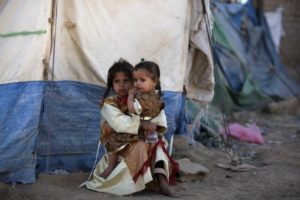Sixty years of refugee crises mean enduring heartbreak
The number of people displaced by conflict is at more than 65 million, the highest level ever recorded.
The UN has estimated that 65.3 million people were either refugees, asylum seekers or internally displaced at the end of 2015, an increase of 5 million in a year. This represents one in every 113 people on the planet.
More than half of them came from war-torn Syria, Afghanistan and Somalia.
Despite the focus on Europe’s migrant crisis, 86 per cent of the refugees are being sheltered in low and middle income countries.
And this year is shaping as the most deadly yet for migrants seeking to cross Mediterranean from Africa into Europe – with around 4,000 deaths by drowning.
 From the Mediterranean to the Andaman, it’s been a season of despair with the faces of migrants haunting television screens and dominating headlines.
From the Mediterranean to the Andaman, it’s been a season of despair with the faces of migrants haunting television screens and dominating headlines.
Harrowing stories have emerged of death, starvation and abuse at the hands of people smugglers. And from the world’s new and continuing conflict zones, there have been new mass movements across borders and within states.
Half a million Yemenis have been internally displaced since March. One hundred thousand Burundians have fled into neighbouring countries since April.
The statistics are staggering – 7.6 million Syrians, homeless inside their own country, now make up a fifth of all internally displaced people (IDPs) in the world.
But although the numbers are difficult to digest and the media images are heartbreaking, humanitarian crises are nothing new.
Here’s a snapshot of migration misery over the past half century:
1939-45: WWII
In the wake of World War II, tens of millions of refugees were part of the largest population movement in the continent’s history.
Millions of Jews sought sanctuary around the world. Many wished to settle in British-ruled Palestine, a place they perceived as their homeland.
When the SS Exodus, a ship full of Jewish refugees, attempted to break the British blockade of Palestine in July 1947, it was intercepted by the British government. In a move at odds with the majority of Western opinion, the passengers on board were sent to internment camps in Germany.
1959: World Refugee Year
By the end of the 1950s, the refugee problem had reached such a scale that the UN General Assembly designated 1959 “World Refugee Year”.
The initiative achieved significant results, with the closure of all post-war refugee camps in Europe by the end of 1960. But globally the number of refugees was not diminishing with millions of fugitives from persecution, hunger and natural disaster seeking refuge in Africa, Asia and the Middle East. Europe, long an exporter of refugees, became a net importer.
1961: Palestinians in exile
After the creation of the state of Israel in 1948, an Arab-Israeli war broke out.
Though an armistice was agreed a year later, hundreds of thousands of Palestinians had been displaced. By 1961, over a million were still living in refugee camps across Egypt, Syria, Lebanon and Jordan. The United Nations provided food, clothing, medicine and shelter at an annual cost of $30 million.
1967: Nightmare in Nigeria
When civil war broke out in the Nigerian state of Biafra in the mid-1960s, the resulting images of starving children provoked horror and sympathy around the world.
The plight of the Biafran refugees caused world-wide protests about the actions of the Nigerian military and government as well as to massive contributions to humanitarian relief efforts.
1972: Ugandan Asians
General Idi Amin’s expulsion of Uganda’s Asian population left about 80,000 people requiring resettlement. A year after seizing power in a military coup, The Ugandan dictator gave the country’s Asians 90 days to leave.
About 80,000 people were expelled and most of those with British passports (approximately 30,000) moved to the UK – the country that had initially taken them from India to Uganda in the late 19th Century.
1979-89: Soviet war in Afghanistan
The Soviet war in Afghanistan created more than five million Afghan refugees, about one third of the pre-war population.
The majority of refugees were taken in by neighbouring nations Pakistan and Iran, with people moving more quickly than new homes could be built for them in refugee camps.
1991-99: Balkans War
Ethnic conflict raged throughout the former Yugoslavia in the 1990s.
It became Europe’s deadliest conflict since World War II, with tens of thousands killed amid claims of ethnic cleansing and numerous other war crimes. More than two million people were either internally displaced or fled the violence.
1994: Rwandan genocide
An estimated 800,000 people were killed in the Rwanda genocide over the course of 100
days in 1994.
Some two million people fled into the Democratic Republic of Congo (then called Zaire) and other neighbouring countries, with cholera becoming widespread in the refugee camps and killing thousands more. The militarisation of the camps also contributed to years of unrest in the region.
2003-16 Sudan’s Darfur conflict
The war-torn region of Sudan has been mired in intense conflict since early 2003.
More than 3,000 villages in Darfur have been destroyed, displacing more than two million people who fled the carnage. Within months of fighting breaking out, so many had poured into refugee camps in neighbouring Chad that a lack of clean water became a new threat to their lives.
In 2011-16 Syrian conflict
In February 2012, many thousands of Syrians were already risking their lives to flee the civil war. It has become the most recent and ongoing crisis that has seen the biggest displacement of people since World War II.
According to the United Nations, around four million Syrian refugees have been registered. Some 11.5 million Syrians, about half the population, have been displaced since the outbreak of civil war in March 2011.
Laurie Nowell
AMES Australia Senior Journalist












